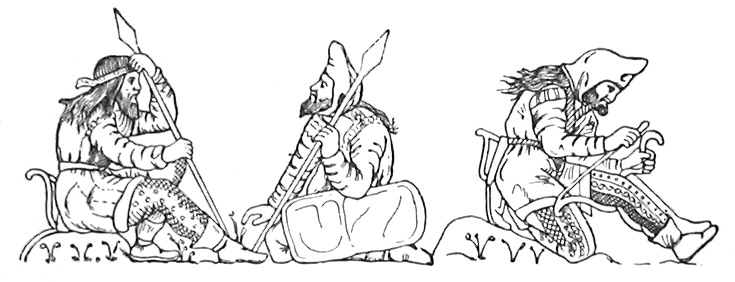Weed and religion have an ancient history that goes back thousands of years and spans across the world.
From Taoism in China, Hinduism in India to Rastafarianism in Jamaica, many different people have used cannabis in their religious ceremonies to reach a higher plane.
Read on for a detailed look at how religions have used cannabis throughout the ages.
Taoism and cannabis
One of the earliest examples of cannabis use in religion can be found in Taoism, the ancient Chinese belief system that dates back to the fourth century BCE.
Taoism is based on the philosophy of Lao Tzu, and became the official religion of China under the Tang Dynasty, which ruled between 618-907 CE. It emphasizes doing what is natural and “going with the flow” in accordance with the Tao, a cosmic force that flows through all living beings and maintains balance in the universe.
Beginning in the fourth century CE, Taoist texts mentioned using cannabis in censers, which are incense burners. According to the Taoist encyclopedia Wushang Biyao, which means “Supreme Secret Essentials,” cannabis was added to ritual incense-burners and ancient Taoists experimented regularly with “hallucinogenic smokes.”
Cannabis was used to eliminate selfish desires, induce feelings of well-being, and achieve a state of naturalness that corresponded with the core Taoist beliefs.
Cannabis consumption was reserved for religious officials and not shared with the common people. Taoist priests and shamans would combine cannabis with ginseng and use it as a means to communicate with good and evil spirits, as well as to forecast the future, believing cannabis had the ability to cast one’s spirit forward in time.
Hinduism and cannabis
Much like how cannabis was mentioned in Taoist texts, it is also brought up in the Vedas, the oldest and most sacred Hindu text that dates back to as early as 1500 BCE. In the Vedas, it is said that cannabis is one of the five sacred plants, and a guardian angel resides within its leaves.
Ancient Hindus believed that the gods sent hemp out of compassion for the human race so that they may attain happiness and lose fear. Other Hindu stories suggest cannabis came from a spot of nectar dropped from Heaven.
One of the Hindu gods most associated with cannabis is Shiva, the god of destruction. According to one legend, Shiva came to know cannabis after both gods and demons churned the ocean to create an elixir of life.
However, one of the byproducts of the churning was a poison called Halahala, which Shiva drank to save others, causing him great agony and his throat to turn blue. Shiva was offered cannabis to ease his pain.
Cannabis has played a sacred and also practical role in the Hindu religion. Since ancient times, Indians have consumed “bhang,” a drink made up of cannabis and milk, with almonds, rosewater and ghee often added. It is said bhang is one of Shiva’s favourite foods, and he is known as the “Lord of Bhang.”
https://www.youtube.com/watch?v=yEhXjnoGriI
Drinking bhang in religious rites is thought to cleanse sins, unite one with Shiva and avoid the miseries of hell in one’s eternal cycle of death and rebirth.
Indians consume bhang during festivals such as Holi or Shivrati, known as the “right of Shiva,” and it gives the festivals a heightened sense of merriment on the streets.
When the British colonized India, they found cannabis use so prevalent that they commissioned a large-scale study on its use in the late 1890s.
There was concern that it was causing psychosis. After years of research by medical experts, The Indian Hemp Drugs Commission Report concluded that cannabis use had roots in ancient Indian culture, had religious value among Hindus and was harmless in moderation.
There was also concern that taking it away would cause an outcry from religious clerics.
Today, cannabis in the form of bhang is so common in parts of India that it can be found in government licensed street stands.
Scythians and cannabis

The Scythians were a nomadic people who traveled extensively around Europe, the Mediterranean, Central Asia and Russia.
They were expert horsemen, and one of the earliest people to use horse-drawn covered wagons. Scythians were known to use cannabis for religious purposes, and scholars credit them for spreading cannabis knowledge throughout the ancient world due to their nomadic nature.
The Greek historian Herodotus (484-425 BCE) wrote about the Scythians’ use of cannabis in ceremonies to purify themselves after the death of their leaders.
He said that the Scythians would fix three wooden sticks inclined towards each other and stretch woolen felts around them, creating a make-shift tent or teepee.
They would then place a dish inside the tent on the ground, put red-hot stones inside it, then throw hemp seeds onto the hot stones and inhale the vapour it created.
“Immediately it smokes, and gives out such a vapour as no Grecian vapour-bath can exceed,” Herodotus wrote in The Persian Wars. “The Scyths, delighted, shout for joy, and this vapour serves them instead of a water-bath; for they never by any chance wash their bodies by water.”
Although this ritual was once thought to be myth, it was verified in 1929 when Professor S. I. Rudenko discovered a Scythian tomb near the Altai Mountains on the border of Siberia and Mongolia.
In the tomb, he found the embalmed body of a man, a bronze cauldron filled with burnt marijuana seeds, as well as shirts woven from hemp fiber and metal censors for inhaling smoke that appeared for recreational purposes.
Two gold bucket-shaped cups were also found in 2013 and are believed to be ancient bongs used by the Scythians.
Inside them was a black substance that tested positive for opium and cannabis, which archaeologist Anton Gass believes were consumed simultaneously.
Cannabis in the Old Testament
There is debate among scholars whether cannabis is mentioned in the Old Testament.
In 1936, Polish etymologist Sula Benet proposed a new interpretation of the Old Testament. According to her, the Hebrew word “kaneh bosm” was mistranslated in the original Greek version of the Old Testament that was written in the third century BCE, and the mistranslation has been repeated since.
According to Benet, the Greeks mistranslated kaneh bosm to be the word calamus, a plant traditionally used to make fragrances, when it in fact it referred to cannabis.
Kaneh bosm appears five times in the Old Testament – in the books of Exodus, the Song of Songs, Isaiah, Jeremiah and Ezekiel. The root word “kan” means “hemp” or “reed,” while “bosm” means “aromatic.”
The first mention of kaneh bosm in the Old Testament happens with the prophet-shaman Moses, when God gives him instructions to create holy anointment oil, with kaneh bosm as an ingredient.
In Exodus 30: 23-25, which dates back to 1446 BCE, God told Moses to create anointing oil with nine pounds of kaneh bosm, six quarts of olive oil, as well as essential extracts of myrrh, cinnamon and cassia.
In ceremonies, the oil would be poured over the head and body of a priest. If one believes the oil contained cannabis, it would then provide psychoactive effects after soaking into the person’s skin, which may have been perceived as a communion with God.
With nine pounds of cannabis, the oil would certainly be potent and could explain the healing miracles of Jesus, as cannabis has been shown to be effective in treating many ailments, from skin diseases and glaucoma to multiple sclerosis.
Author Julian Jaynes, who wrote The Origin of Consciousness in the Breakdown of the Bicameral Mind, argues that ancient people were not as self-aware as modern humans, and so may have perceived their own cognitive functions when high as voices from God.
Benet also details how the Israelites may have gotten knowledge of cannabis from the Scythians. Moses and his priests would burn incense and use holy ointment in a portable “tent of meeting,” similar to how the Scythians also used tents for cannabis consumption.
Since the Scythians and the Israelites traded goods and knowledge, it makes sense they would use the similar tent technique.
There is some skepticism whether kaneh bosm actually refers to cannabis, though.
Lytton John Musselman, author of A Dictionary of Bible Plants, argues that calamus actually is capable of producing medicinal effects equal to those described in the Bible.
Rastafarianism and cannabis

Rastafarianism is a social movement and religion created in the 1930s by Jamaican preacher Leonard Howell. Howell claimed Emperor Haile Selassie I of Ethiopia as the second coming of Jesus Christ, and that Africans were the chosen people and Ethiopia was their promised land.
Rastafarianism is very connected to cannabis, as is often depicted in popular culture.
However, Rastafarians condemn the use of cannabis simply to get high, along with the use of other drugs, such as alcohol, tobacco, caffeine, heroin or cocaine, which are viewed as poison that defiles the body.
Rather than using cannabis just to get high, it is primarily seen as a gateway to understanding–cannabis is known as “wisdom weed” in the culture.
Rastafarians believe that the “Tree of Life” mentioned in the Bible is in fact cannabis and that passages in the bible promote its use.
These passages include: “He causeth the grass for the cattle, and herb for the services of man” (Psalm 104:14), “Thou shalt eat the herb of the field” (Genesis 3:18), “Eat every herb of the land” (Exodus 10:12) and “The herb is the healing of the nations” (Revelation 22:2).
Rastafarians consume cannabis in a ritual called “reasoning sessions,” often using a shared pipe called a chalice that is passed around like a Christian communion cup.
Reasoning sessions involve group meditation, and cannabis is thought to help individuals go to a trance-like state where they are closer to their inner spiritual self and God, which goes by the name Jah in the religion.
A short prayer is always recited before the cannabis is smoked: “Glory be to the father and to the maker of creation. As it was in the beginning is now and ever shall be World without end.”
Reasoning sessions are very important in Rastafarianism, as it is a time to debate how to live according to the Rastafarian outlook.
Weed nuns
Cannabis is taking on a life of its own in modern times now that it is legal in Canada and multiple states in the U.S.
One of the more prominent examples of a movement being formed around cannabis is the group the Sisters of the Valley, a group of women dressed as nuns who grow and sell cannabis while extoling its virtues and have come to be known as the “weed nuns.”
The group was started by Sister Kate, whose real name is Catherine Meeusen, in 2014. In 2011, Sister Kate began calling herself a “nun” in response to the U.S. government calling pizza a vegetable. If the government could give pizza such a label, why couldn’t she give herself a label as well?
Sister Kate says that she didn’t just call herself a nun out of protest towards the government, but also as a nod toward nuns’ history of activism in America, such as during the civil rights movement.
Operating out of Merced County, California, nine “nuns” are employed, and the group produces mostly hemp with high cannabidiol (CBD) levels to be used for medicinal rather than recreational purposes. They also create balms, tinctures, oils and soaps from the hemp.
They create the products in strict adherence to the moon cycle, which they believe imbues healing powers. A ceremony for a new moon marks the beginning of a new production cycle, which lasts about two weeks.
The Sisters of the Valley model themselves after the Beguines, an ancient order of female healers from around 600 CE who lived communally and created herbal medicine. Women take a vow before joining the group to live simply, to have obedience to the moon cycle, and to be of service to the people.
Clearly, cannabis has a lengthy history as part of religion, and has often been used for its calming effects and ability to reach higher mental terrain.
While some accounts of its use are contested, its natural prevalence and easy ability to grow makes it hard to discount its existence throughout human history.
As legalization spreads around the world, new uses of the plant and beliefs surrounding it may continue to sprout as people search for greater meaning and truth in the world.









Honey Smith Walls February 9, 2020 at 3:21 pm
Loved this timely article about women's place in society as our leading 2020 female politicians try to get more media attention than is so easily awarded to men. Not a man-hater, just see the obviously imbalanced world we live in and want a change, desperately, that can only come with the heart of a woman in charge. Which has never been tried in the US. After President Pussygrabber, I need a place to land. Are there any local chapters still in existence? Maybe if woman band together with Beguines and swear never to part their legs until a woman is allowed to be president.... I don’t know. I suddenly feel like we’re back in the Middle Ages with this clown in charge.
Malcolm Ellis November 22, 2020 at 6:21 pm
Most of humanity just wants just to live in peace and help one another without vast sums of money involved, unfortunately we have a small minority of the world population that have become to greedy for their own good and creating an economy that could lead to another world war, is that what life is all about, for me I will kiss my pipe for god knowing he will come, the light will be blinding and the sound will be amazing as it starts to rip through your body with no time to even kiss your ass goodbye so don't say I didn't warn you people, but you were to busy squabbling amongst yourselves Lucifer looks forward to meeting you soon the Devil reigns over you with their wealth and their power don't forget its our own people that have become divided, again all the work of Lucifer that is how clever he is folks, cannot for you see that you are being slowly dragged into hell as humanity falls apart.